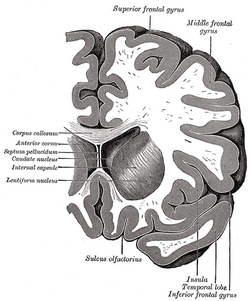| Brain: Superior frontal gyrus | ||
|---|---|---|
| Superior frontal gyrus of the human brain. | ||
| Coronal section through anterior cornua of lateral ventricles. | ||
| Latin | ' | |
| Gray's | subject #189 821 | |
| Part of | ||
| Components | ||
| Artery | ||
| Vein | ||
| BrainInfo/UW | hier-65 | |
| MeSH | [1] | |
The superior frontal gyrus makes up about one-third of the frontal lobe of the human brain. (A gyrus is one of the prominent "bumps" or "ridges" on the surface of the human brain.)
The superior frontal gyrus, like the inferior frontal gyrus and the middle frontal gyrus, is more of a region than a true gyrus.
The borders of the middle frontal gyrus are the superior frontal sulcus below; the medial longitudinal fissure along the midline of the brain; and the precentral sulcus behind.
| This page uses Creative Commons Licensed content from Wikipedia (view authors). |

